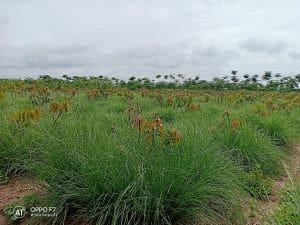
Over the years many people have started using vetiver and, in the process, have joined various vetiver social media groups. I realize that many of them find the amount of information available overwhelming, and often not easy to find. This newsletter delves into both past and present selecting a few observations that support current interest and applications of vetiver in the agriculture sector – specifically for farmers and horticulturists. But first………
India Vetiver Foundation (IVF)
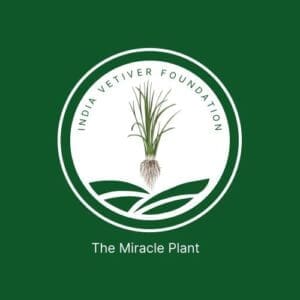
The Agriculture World Vetiver Whats App group continues to expand – like an octopus with many legs – moving, wriggling, and feeling out the many potential avenues and means, both environmentally and commercially, that could and should use vetiver. IVF under the leadership of C.K. Ashok and P.N. Subramanium is starting to take shape, and this newsletter celebrates both IVF’s new logo and the work of Patanjali Jha and his extended family in the restoration of degraded lands into food forests with vetiver as the critical starting point. Patanjali and his brothers are leaders in this technology. Their farms show how effective this transformation can be and over a very short time. These two photos show such transformation over a three year period.
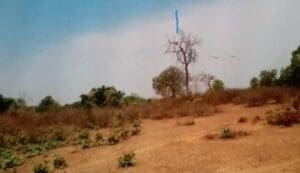

Patanjali writes: “The above degraded land (photo 2), with vetiver as one layer, has, after 3 three years of no-till and no chemicals, transformed the compacted soil of my brother’s farm into a multi-layer permanent food forest, photo 4). This unique regenerative experiment holds promise for quick reduction in soil temperature, improved recharge and purification of ground water, and other environmental and economic benefits …. The planting comprised vetiver, black turmeric, moringa, agastya, subabool, citrus — my favorite “gondhoraj” lemon, guavas, jamun, jackfruit, neem, and bael. Bamboos, Kari patta, karonda are on the boundary as densely grown live fencing. Every inch of soil, is covered with abundant growth …. An NGO followed our technique, and to their delight within one year found a well was full that otherwise would be dry… now they are doing this with 100 of wells and denuded hills using vetiver, trenches and seedballs. We gifted them one seedball machine. This year my best friend has gifted 10 more seedball machines. Our experience is that seedballs germinated and survived the best with vetiver and shrubs …. cheapest way to green mother earth.”
Seedball machines are relatively easy to make. See design instructions
Vetiver Grass Application Designs for Farms.
Climate change and deteriorating soil health threatens food security and long-term agriculture sustainability requires a fresh look at the Vetiver System (VS) as a technology that is more than just a soil conservation tool for the agriculture sector.
Studies and user feedback indicate that users (farmers) grow vetiver grass for many purposes and that soil conservation may not always be the highest priority. The need to respond to declining soil moisture, extreme weather events, higher soil temperatures, high cost of agriculture inputs (fertilizer, pesticides, fuel) has furthered the need for solutions that are Nature-based, sustainable, and low cost — farmers are starting to see and understand the multipurpose/benefits of this unique plant. As a result, there is increasing on farm design “experimentation” that has proven interesting and is being adopted by others.
The facts:
- Vetiver grass is scale neutral and when planted as a dense hedgerow is the most effective Nature-based technology for controlling erosion and for reducing rainfall runoff especially under extreme rainfall events, and results in reduced soil fertility losses and improved soil moisture.
- Vetiver grass when used as a mulch further reduces soil loss from erosion and increases soil moisture. The mulch reduces soil temperature by as much as 15⁰C under extreme heat conditions; mulch degradation improves soil organic matter, enhancing soil micro flora and fauna activity, recycles soil nutrients, and reduces weed growth.
- Vetiver grass is a habitat for beneficial parasitoid wasps, it can be a dead-end trap crop for some insect pests, acts as a windbreak, and will remove excess and unwanted toxic chemicals in the soil.
- As a compost (“Veticompost”), providing added soil nutrients.
The above are backed by scientific and field-based data from widely spread countries in the tropics and semi-arid regions of the world and can be found by searching the TVNI website.
Application design:
Farm vetiver applications are primarily in the form of dense contour hedgerows applied as an alternative to constructed graded terraces, the latter designed to reduce soil erosion and discharge surplus rainfall runoff to waterways, drainage lines, and streams. Because of better recognition of the many attributes of vetiver (see FACTS above), there is a move to further integrate vetiver with associated annual and perennial crop management practices, and at various scales. There are about six farm vetiver design “groups” that can be used as specific applications, or mixed, depending on land use and planned farm/crop management practices:
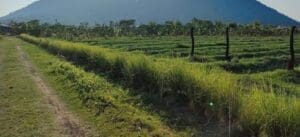
Design 1. Farm/Field boundary hedge – (particularly for small farms, and domestic and commercial vegetable nurseries and gardens). These closely planted hedgerows can be planted to demarcate the production unit, reduce erosion and rainfall runoff, act as windbreaks, prevent the movement of chemicals from neighboring farms, and provide wildlife habitat.
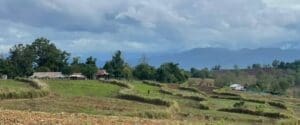
Design 2. Protection against flood damage and erosion caused by extreme weather (rainfall) events consisting of closely intra-plant spacing (15 cm) vetiver hedgerows planted on the contour (often an average contour) with hedgerows normally at 2m Vertical interval apart (variations up to 4 m VI depending on the type and planting design of the inter hedge crop are acceptable). The object is to have a hedge with no gaps that will: trap sediment; spread-out rainfall delivered to the hedge, (often as concentrated flows from rills and small gullies); and overtime lessens the slope of the land through natural terracing. Improved groundwater recharge is generally associated with such hedges. These hedgerows provide insurance against catastrophic climate related events. These dense contour hedgerows can function as key-lines for inter hedge management practices.
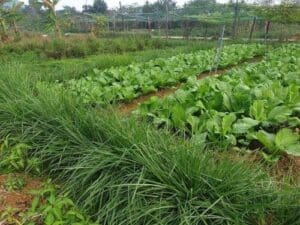
Design 3. More hedgerows can be added as an integral part of crop specific management practices and are installed to capitalize on the potential crop symbiosis, for biomass production for mulching and forage.
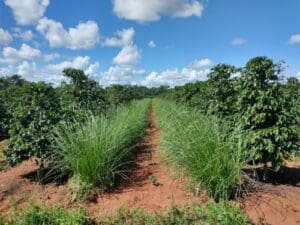
Design 4. Stand-alone (non-hedgerow, off contour hedges) planting either in rows or in ad hoc patterns with the objective of directly benefiting nearby crop plants (including trees (restoration), perennial tree crops, food forests) – such benefits include: chop and drop mulching, shared mycorrhiza activity, water/nutrient transfer, pest reduction (termite deterrent, dead end trap function, habitat for beneficial insects).
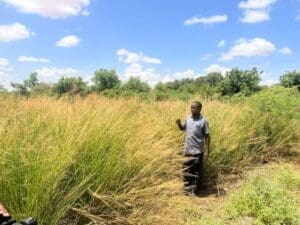
Design 5. Planted as a vetiver “crop” for vetiver oil, forage, thatch, furnace fuel, and multiplication/propagation – 30,000 (30X100 cm) to 90,000 (30×30 cm) plants per ha. Could such plantings be on a rotational (5 year?) basis with other crops, providing benefits of improved soil organic matter (SOM and SOC), fertility, and cleanup of unwanted agriculture and other chemicals and other contaminants like arsenic?

Design 6. Applications for gully control, land restoration, infrastructure protection, and pollution control. Examples of these applications can be found on the TVNI website.
All the above design applications can be used at any scale. The unique characteristic of vetiver allows multiple design applications to be retrofitted to farm practices without upsetting neighboring landowners; to the contrary most vetiver applications on one piece of land will benefit neighboring and down watershed landowners.
Vetiver grass technology information sources.
We are repeatedly asked many questions (that we gladly answer) that in fact can be easily found on the Internet. Here are the prime centers of information.
TVNI Website:
There is a huge amount of information on the site and you can find information through the search button located on the header menu (use key words), the Document Center , and a link to Vetiver Conference Proceedings (that I use frequently). I really advise taking just a little bit of time to see what is behind the many menu headers.
TVNI Newsletters:
Apart from the current (starting in 2022) series of website posted newsletters, Jim Smyle, Joan Miller (Jim’s wife) and I created hard copy newsletters from 1990-2002. These newsletters record the research and development of the Vetiver Grass Technology following its introduction by John Greenfield to Indian watershed programs starting around 1986. They contain invaluable data from all the major continents. The information is just as relevant today as it was 25-35 years ago, and provides data for future vetiver related planning, as well as providing useful information to vetiver users. For the latter there are articles relating to propagation, spacing, tillering, nutrient requirements, and management of nurseries and application sites. The newsletters are in a single 830-page pdf file (50MB) that can be downloaded from TVNI’s Google Drive account at no cost. The file and its contents includes a large table of contents linked to individual pages (you may need to download it for the links to function). You can also use your browser or pdf reader search boxes to find information using key words. Before embarking on new research, particularly in soil and water conservation, use this file to check to see if it hasn’t been done before!
TVNI Webinar and Video Channel.
The channel has some good videos on various vetiver topics. This channel is still “young” and underutilized. If anyone has a video that they think would be useful and are willing to share on the channel, please let us know and send the URL and permission to use.
Vetiver Related Social Media Group Platforms.
I personally find some interesting posts on these platforms. The two that I most frequently visit are The Vetiver Network International (TVNI) Group and the Vietnam Vetiver Farmers Group . There are some other platforms that are expanding including the Pacific Islands Vetiver Community Based Network Inc. I find that the easiest way to explore these platforms is either by browsing the “media” and/or using the platform search button. For those of you who have vetiver related social media accounts it is important to add regular new posts, and when you do add images, you need to include explanatory text (what, where, and why).
Vetiver application on large farms.
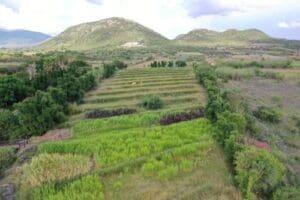
Most of our attention has been on vetiver applications for small family farms, however vetiver can and is solving some of the land and water issues facing commercial farms. Where labor costs are high it is quite possible to mechanize the planting and maintenance of vetiver hedgerows, nurseries, and vetiver “crops”. A new presentation has been prepared that might be useful as a starting point in discussing VGT with larger farm enterprises.
Vetiver applications – kitchen gardens and other small scale vegetable operations.
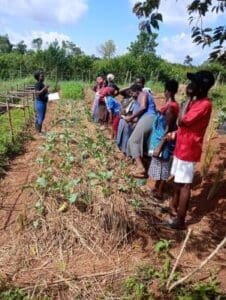
Many kitchen gardeners aim to produce food with minimum or zero chemical use. Vetiver’s multiple benefits and applications fit the purpose. Here are some excerpts from a note (2002) by Don Thompson of Belize:
… I acquired two bags of vetiver tillers in May 2000 from Belize Sugar Industries, and from this material I started a nursery …. The nursery was planted in June 2000 and remained undisturbed until June of 2001. …. vetiver tillers were planted extensively throughout my entire garden, occupying about 80% of the available garden space. I also began to establish vetiver as the sole plant material for the boundary (fence line) of my 1-1/4 acre citrus farm. As a result, vetiver will now form the foundation for my entire gardening program.
Planting System: For the first year and half, I planted solid clumps of 5 to 8 roughly prepared, tightly packed tillers into planting holes spaced about 60 cm apart. Now I prepare planting material by separating tillers into individual pieces, washing off all soil, and removing dead pieces, and finally trimming the roots and tops. I now plant the individual tillers in a shallow trench (with the dug soil heaped on only one side) that runs for whatever length and direction required. Where conditions permit, I dig the soil to only one side of the trench. Then sprinkle a small amount of slow release 17-17-17 fertilizer into the bottom of the trench. Tillers are placed in the trench, 3 to 6 cm apart, not vertical, but lying at an angle against the side of the trench, opposite to the side of the heaped soil. After the trench is lined with tillers, I simply take a rake and pull the heaped soil over the roots of the tillers leaving a small point of each tiller poking through the soil. This method is much faster than trying to hold each tiller in a vertical position. Very little of the plant is exposed to the open air which helps to protect the tiller from drying out in the hot sun. Initially the grass grows out at an angle but after a month becomes vertical. …. During the dry season I leave it standing as a windbreak to reduce the high evaporation rate.
Mulching System: Beginning late September 2002, mature vetiver grass plants have been systematically cut for mulching material. These mature plants have grown to a height of about 170 cm. …. I cut the grass (for mulch) close to the base of the plant with stem lengths of only 6 to 12 cm. After the leaves have re-grown for a few weeks, I drench the re-growth with a liquid fertilizer containing micronutrients. By doing this I figure I can convert inexpensive chemical fertilizer into high quality organic fertilizer once the grass is cut for mulch. Beginning in 1997, I constructed the garden as a raised bed gardening system. The construction of the raised beds was time consuming and labor intensive. In the dry season the beds would dry out rock hard and then when the rainy season began, the beds would rapidly become covered in weeds, which were difficult to eliminate. During this period, I used wood shavings as mulch between the raised beds. Now, I have abandoned the raised bed method and have switched to a vetiver grass mulch bed system on level ground with little or no digging. The rows of vetiver are spaced about 280 cm apart and the area between the rows is covered with vetiver grass mulch. Over time the grass mulch breaks down, forming a bed of rich organic matter. The mulched soil between the rows of vetiver is already improving with respect to drainage, moisture-holding capacity, weed suppression, and fertility. Further, the rows of vetiver function as an effective windbreak, especially tempering the hot, drying winds that blow during the dry season. In conclusion, the use of vetiver grass as applied to my gardening project is having a positive impact on the entire ecology of the garden area. Previously, I experimented with all sorts of different gardening techniques, but this vetiver mulch system is the only one that shows clear evidence that a continuous improvement is taking place.
Taweeksak – a farmer/horticulturist from Thailand wrote on Facebook:
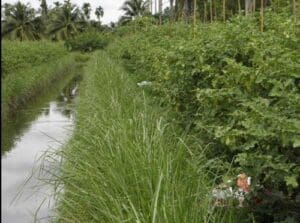
“Please look at all these photos https://www.facebook.com/groups/vetivernetwork/permalink/10155871151977760/ carefully. This farm belongs to my eggplant seedling customer. What is being done with vetiver on this farm has changed me forever. In May 2011, I visited this farm intending to inspect my eggplants to see if there was a problem. I saw a worker cutting a tall grass at the rim of a bed. Instantly I realized it was a vetiver row along the edge of every bed. I told the farmer that I don’t care about his eggplant for now, instead let’s talk about all this vetiver. I’ve learned a lot from him. He told me that it might be a little difficult to work on his farm when the vetiver gets too tall, but his worker gets used to it. He gets free mulching every month from vetiver cutting. The pond bank was very secure. …
That day I came home happy. My dream was endless. I started to learn more. Playing around with vetiver I see lot of projects about vetiver by the government in Thailand. I read a lot of studies. Now I understand why the use of vetiver is limited. Maybe we put too much money into it. It should be in the hands of committed personnel and must be monitored.”
More on vetiver mulch.
Climate change and deteriorating soil health is forcing farmers to look for alternative management practices that reduce the use of agricultural chemicals, improve soil moisture, increase soil organic matter, and reduce the impact of extreme temperatures. Vetiver applications in their various design forms provide some solutions including the use of vetiver mulch. Here follows summaries of some research undertaken in past years.
Nigeria – – Effects of vetiver grass strips, vetiver grass mulch and an organo-mineral fertilizer on soil water, nutrient losses and maize yields on an Alfisol. (Babalola et al)
Experiments were conducted to evaluate the use of vetiver grass strip (VGS), vetiver grass mulch (VGM) and an agronomic practice using an organo-mineral fertilizer (OMF) …… Soil physical conditions in terms of soil bulk density, soil organic matter and soil infiltration characteristics were significantly improved by the treatments ……
- Runoff and soil loss on VGS plots were reduced by 229% and 253% respectively over the control plot. Adding 2 tons of vetiver grass mulch, these values were further reduced by 62% and 102%, respectively. Adding 6 tons/ha of mulch, VGM was 34% more effective than VGS in reducing runoff.
- Mean soil losses were 67% and 152% lower on VGS than VGM plots at 4 and 6tons/ha, respectively.
- Mean NO3-N levels in runoff water were significantly affected by treatments. Mean NO3-N levels in runoff water were 52.5% and 147.5% higher on the control and OMF plots respectively compared to the VGS plots.
- Nutrient (macronutrients and micronutrients) loads of eroded sediments were highest for OMF plots and least for VGS plots. Carbon, Nitrogen and P contents of eroded sediments on VGS plots were 22% to 23%, 12% to 36%, and 21% to 38% lower on VGS plots than other treatments.
The significant beneficial effect of OMF in producing the highest yields was overshadowed by the danger of water pollution by nutrient loads in the absence of a soil erosion control measure. Although the differences were not significant, grain yields on vetiver grass mulched plots (VGM) were 4% and 47% higher than on VGS plots when 4 and 6 tons/ha of grass mulch were applied. For maximum benefits, VGS and VGM should be combined to optimize soil improvement, water, and nutrient conservation for improved crop yields.
China — Effects of vetiver hedges and mulch on micro-site factors in a citrus orchard.
Experiments in China in 1992 showed just how effective vetiver could be when used in citrus orchards — Dr. Chen Kai working (1993) with the Department of Horticulture at Nanjing Agricultural University in Jiangsu Province, PR China, writes:
“Based on 4 replicated trials in our department’s orchards we have come to the preliminary conclusion that vetiver hedgerows and mulches have a significant, beneficial impact on a number of micro-site factors. We attribute its utility, and thus its beneficial impacts, to 1) its rapid growth and significant accumulation of annual biomass, and 2) its excellent adaptability to the periods of extreme temperatures and water stress found in the eroded red soils regions of southern China.
Mulch production from vetiver hedgerows (in tons green weight per 1000 m2 of hedgerow) averaged 11.4, 14.7 and 17.8 in years 1, 2 and 3, respectively. (Ed. Note: 1000 m2 of hedgerow is equivalent to about 4,000 linear meters of hedge – 25 cm cross section at base. At 15 tons/1000 m2 , a 100 m vetiver hedge would yield about 375 kg green biomass – in most instances a bit on the high side — applying at a rate of 6 tons per ha, using chop and drop harvesting, hedges would need to be spaced 6 meters apart).
Hedgerows, functioning 1) as wind- breaks, 2) to shade the soil, and 3) as a source of mulch provided a synergistic effect resulting in amelioration of the micro-climate. For example, on 22 August 1992 the differences between the controls and the vetiver treatments were measured. Air, soil surface and rhizosphere temperatures were all lower in the vetiver treatments. Also, in the vetiver treatments, relative humidities and soil moisture contents were higher; diurnal temperature fluctuations were less than half of the control’s (Table 9). 
Three years of mulching and erosion control with the vetiver hedges also significantly improved the orchard soil’s physical and chemical properties (Table 10).
In view of our findings, we have extended the use of vetiver throughout the orchards in our experiment station.”
Nigeria: Comparative effects of vetiver grass prunes, vetiver hedgerows and vetiver mulch on soil quality and erodibility of a degraded soil.
(by K.S Are et al. Institute of Agricultural Research and Training, Obafemi, Awolowo University, Moor Plantation, Ibadan, Nigeria, and Department of Agronomy, Sardarkrushinagar, Dantiwada Agricultural University, 385 506, Gujarat, India)
 This experimental work concluded — Vetiver system either as VGS, VGM or veticompost could be a better choice in soil quality build-up as well as reducing soil erodibility in an erosion prone land. Although the resistive ability of VGM and veticompost in trapping sediments was lower (not significant, P<0.05) than that of vetiver strips (VGS), application of vetiver mulch and veticompost led to soil quality build-up and were significantly higher than that of VGS plot. The use of vetiver hedgerows alone may not be able to sustain continuous cropping in erosion-induced degraded land unless a nutrient released organic material such as veticompost and vetiver mulch are applied for the build-up of soil organic matter to increase soil fertility as well as overall soil quality.
This experimental work concluded — Vetiver system either as VGS, VGM or veticompost could be a better choice in soil quality build-up as well as reducing soil erodibility in an erosion prone land. Although the resistive ability of VGM and veticompost in trapping sediments was lower (not significant, P<0.05) than that of vetiver strips (VGS), application of vetiver mulch and veticompost led to soil quality build-up and were significantly higher than that of VGS plot. The use of vetiver hedgerows alone may not be able to sustain continuous cropping in erosion-induced degraded land unless a nutrient released organic material such as veticompost and vetiver mulch are applied for the build-up of soil organic matter to increase soil fertility as well as overall soil quality.
The above experimental data is just a sample of many other studies in different countries mots of which draw similar conclusions.
World coffee production could be under threat from climate change particularly due to increasing soil temperatures, reduced soil health, and increased pest threat. …. Vetiver mulch might help reduce this disease.
Soil temperature significantly influences the development of Coffee Berry Disease (CBD) caused by the fungus Colletotrichum kahawae. Here’s how soil temperature affects CBD:
- Germination and Dispersal: Rainfall is necessary for spore germination and dispersal of C. kahawae. Optimal soil temperatures for spore germination and mycelial growth are around 20–22 °C (68–72 °F). Warm soil temperatures promote the initial stages of the disease cycle.
- Temperature-Dependent Growth: The fungus thrives within a specific temperature range. Cooler soil temperatures slow down its growth, while warmer temperatures accelerate it. Soil temperature affects the rate of mycelial growth and spore production.
Mulching can play a role in retarding the development of Coffee Berry Disease (CBD) caused by the fungus Colletotrichum kahawae. Here’s how mulching affects CBD:
- Moisture Regulation: Mulching helps retain soil moisture around the base of coffee trees. Consistent soil moisture reduces stress on the trees and minimizes conditions conducive to CBD development. Dry soil can lead to increased disease severity.
- Temperature Moderation: Mulch acts as an insulating layer, moderating soil temperature. Stable soil temperatures reduce the likelihood of rapid fungal growth and spore production. Extreme temperature fluctuations can stress the trees and exacerbate CBD.
- Weed Suppression: Mulching suppresses weed growth around coffee trees. Weeds can serve as alternative hosts for the CBD pathogen. By reducing weed competition, mulching indirectly limits disease spread.
- Organic Matter Decomposition: As mulch decomposes, it contributes organic matter to the soil. Healthy soil with adequate organic content supports vigorous coffee tree growth and resilience against diseases like CBD.
Note: Coffee Berry Borer (CBB) is another major economic pest of coffee. Explorations for natural enemies of CBB in Africa have revealed several parasitoid wasps that may be useful as bio controls for this pest. Cephalonomia stephanoderis and Prorops nasuta are larval-pupal ectoparasitoids of CBB that usually prey on females, eggs, and first instar larvae and have been introduced as a biocontrol in the Americas. We need to find out if these wasps find vetiver as good habitat. Some years ago a coffee farmer in Zimbabwe commented positively about the wasps in the vetiver adjacent to his coffee.
Mapping vetiver locations.
For a few years now we have encouraged vetiver users to locate their planting applications on our community “Vetiver System Global Project” hosted by iNaturalist. To date we have 900 entries – many of them rather interesting – with some useful photos too. I would encourage you to sign up with iNaturalist and join the community project. If you are unsure how to use iNaturalist here are a couple YouTube videos that are worth looking at:
How to make an observation on iNaturalist using our mobile app
How to add an observation to a project on iNaturalist
Field scale planting of vetiver for forage, fuel stock, land decontamination.
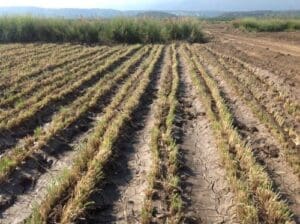
Gueric Boucard, Dominican Republic, a long-time vetiver oil producer in Texas and Dominican Republic grows vetiver for biomass fuel and forage. He is hoping to develop the best management practices. Here is a note on the subject:
” I asked our farm Manager and French Agronomist, Michel, to plant at our DR plantation, a high-density vetiver area just to see if it will eventually grow together solid or be stunted by its own shade.
You can see that we planted fairly large slips with ten tillers or more. We planted the slips on a (double row) about 12-16″ apart on either side of the “hill”, leaving the “valley” for flood irrigation applied during the first 3 months. … this type of planting should make a great biomass fuel mine (renewable). You should note that once the clump is mowed flush, the tractor wheels riding over it, will NOT kill the vetiver. And so, even if the clumps grow completely together, riding over the “vetiver lawn” with a small tractor to mow it every 6 months, is not expected to be a problem.
At another location, where the soil is too hard to harvest roots (for oil), we have decided to abandon the root harvest (in that part of the plantation) and do a combination “biomass fuel plantation” and “feed lot plantation”. The idea is to turn arid and saline land, where nothing useful grew before, into a green pasture for raising cattle. We will first mow (cut) the lignified leaves of mature plants for biomass, bale the cut leaves, and remove the bales. We will then let the young tender shoots grow back about 30-40 cm tall and let the cows in, to feed. (I remember reading that protein content is higher in the young leaves) Then, we will remove the cows, and let the plants grow back to full size, for another cycle of fuel and feed”.
Vetiver and Weediness?
Although we never get reports on the vetiver being invasive, we do get requests for evidence that it is not invasive. So – once again here are references that support not the non-invasiveness of vetiver.
Ecological impact of vetiver in foreign environments
The potential of vetiver grass to produce fertile seed when used for roadside stabilization in Cook Shire
SUNSHINE’ VETIVER GRASS Chrysopogon zizanioides (L.)Roberty – USDA NRCS Plant Guide.
Pacific Island Ecosystems at Risk (PIER)
DNA Analysis of Genetic Diversity of vetiver and future selections for use in erosion control
Vetiver related social media platforms – some advice to “moderators” and “posters”.
If you manage a social media platform or post on group platforms it is important that the posts and comments should be of interest, informative, and of relevance. A photo can tell a thousand words, but we in the vetiver world are also interested in the location of the activity shown in the photo, what and how the vetiver is being applied, and any interesting observations that would be of benefit to the group at large. Our posts, where called for, like to be “liked”, but we don’t need excessive congratulations, memes etc. – they just clog up the system. It is important that you as “moderator” keep the platform moving and relevant by adding useful posts and comments. If your platform stays static and, dare I say “boring”, interest will fall away. We don’t want that to happen.
New Facebook page “Vetiver In Kenya” Looks promising. It runs in parallel with a Whats app group of the same name. Both make interesting following.
New Vetiver website of merit – USA – Texas – Mosquito Hawk Vetiver Grass Farm.
Dick Grimshaw. April 2024